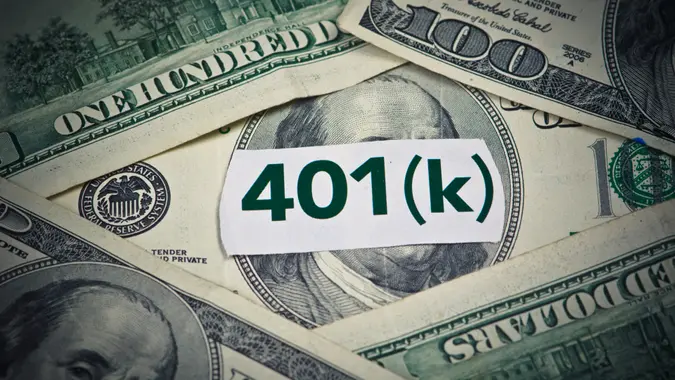4 Steps To Retire as Richly as People Did 30 Years Ago

Commitment to Our Readers
GOBankingRates' editorial team is committed to bringing you unbiased reviews and information. We use data-driven methodologies to evaluate financial products and services - our reviews and ratings are not influenced by advertisers. You can read more about our editorial guidelines and our products and services review methodology.

20 Years
Helping You Live Richer

Reviewed
by Experts

Trusted by
Millions of Readers
There are many reasons why Americans today are struggling to retire like they did 30 years ago. Things like student loan debt or credit card debt hold some people back from saving enough for retirement. Pensions are not as common as they once were, and most workers do not stay at one job long enough to receive one anyway.
Add in Social Security issues, lifestyle creep and recessions, and it is no wonder many people struggle with retirement. Thankfully, there are ways to retire as richly as people did 30 years ago.
“People who retired 30 years ago worked and saved in a different era,” said Stephen Kates, CFP®, principal financial analyst for Annuity.org. “A worker retiring at 65 in 1994 was born in 1929 and grew up in the shadow of the Great Depression. Many workers of this era managed a budget carefully, looking for any opportunity to save a little on their necessities. The Great Depression impressed upon millions of people that making the most of what you have is essential. As the economy boomed in the post-war decades, many of these individuals maintained their frugal habits even as their income and wealth grew.”
Kates went on to discuss how the common wisdom throughout the following decades was that a successful retirement was built like a three-legged stool. It was supported by Social Security, private pensions and personal savings.
Unfortunately, our mindset today needs to shift slightly if we want to retire as comfortably.
Don’t Rely Only on Social Security
Some experts recommend expecting to spend about 80% of your pre-retirement income per year during retirement. You’ll need to save quite a bit of money to reach that amount, and relying on Social Security alone won’t cut it.
The maximum monthly Social Security benefit in 2024 is $4,873. To receive that amount, you had to have had a long and highly paid career. However, according to the Social Security Administration, the average monthly payout is closer to $1,907 for 2024. This amounts to just under $23,000 a year. This won’t be enough for most retirees to live on, especially if you follow the 80% rule. Even if you receive the maximum Social Security benefit amount at age 70, it would only equate to $58,476 a year.
“Although most Americans pay into Social Security during their earning years, it is vitally important that Social Security is not your predominant retirement income,” said Sidney and Saundra Curry, founders of BC Holdings of TN, LLC. “Invariably, upwards of 55% of Americans rely solely on Social Security in retirement. Pairing Social Security with withdrawals from workplace retirement funds, pensions and investment income on the outside is the preferred path to fund retirement.”
Take Advantage of Your Employer’s Full 401(k) Match
An employer-matching 401(k) is the closest thing to a pension that many Americans have. If your employer offers a 401(k) match, you should take full advantage. Some employers match whatever the employee contributes to their 401(k) plan, often up to a certain amount or percentage of the employee’s salary. This is essentially free money employers offer, so it’s a no-brainer to take advantage of the full amount, if possible. If you aren’t sure if your company has a match, contact your employer’s human resources department.
Invest Wisely
Investing is often the most beneficial way to grow your retirement savings. It allows you to take advantage of capital markets and compounding returns. Your investment portfolio and strategy will depend on your risk tolerance and timeline for retirement. As these things change over your lifetime, so should your investments.
When you are starting, you want an aggressive investment strategy that is heavy on equities since you have time to recover from drops in the market. As you age, you may want to adopt a more conservative investment stance as your risk tolerance changes and you get closer to retiring. You should always include some growth component in your investment portfolio to protect against inflation and so that you don’t outlive your savings.
“One of the most critical factors in securing a comfortable retirement is starting to save as early as possible,” said Tyler Meyer, CFP®, founder of RetireToAbundance.com. “The power of compound interest cannot be overstated; it allows your investments to grow exponentially over time.”
Meyer said that the earlier you start, the more time your money has to grow and the less you need to save each month to reach your retirement goals.
Take Advantage of Catch-up Contributions If You Qualify
If you are 50 or older, you can take advantage of catch-up contributions to save more for retirement on a tax-advantaged basis. The additional savings allow those who are behind in saving for their retirement to “catch up.” These contributions raise the ceiling of the IRS’ annual limitations for retirement contributions, and you’re eligible at the start of the calendar year that you turn 50.
The catch-up contribution limits vary based on the retirement account type. For 2024, the catch-up contribution amount was an added $7,500 for 401(k) accounts, $1,000 for traditional IRA accounts, $1,000 for Roth IRA accounts, $3,500 for SIMPLE IRA accounts, and $7,500 for 403(b) or 457(b) accounts.
These are the additional amounts that you are allowed to contribute, so the total contribution amount for 2024 is $30,500 for 401(k) accounts, $8,000 for traditional IRA accounts, $8,000 for Roth IRA accounts, $19,500 for SIMPLE IRA accounts, and $30,500 for 403(b) or 457(b) accounts.
Retirement may look different for today’s workers than people 30 years ago. Many of our grandparents could work a stable job, retire at age 65 and live a comfortable lifestyle. That can still be possible for some people, but you need to plan ahead and be proactive about having enough money saved for retirement. Don’t rely just on Social Security, take advantage of your employer’s full 401(k) match, invest wisely and take advantage of catch-up contributions if you qualify.
 Written by
Written by  Edited by
Edited by 

























